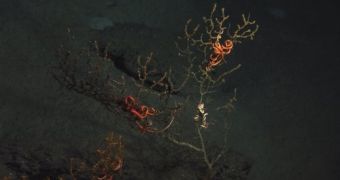A team of biologists found a graveyard of deep-sea gorgonian corals, 11 kilometers south-west of the Deepwater Horizon oil spill in the Gulf of Mexico.
These corals, which used to be quite colorful before, are now brown and have layers of peeling tissue, and it is known that when coral get stressed, they release mucus which traps debris.
For now, the corals have not yet been analyzed, and the researchers only have the pictures taken by the remotely operated vehicle Jason 2.
A thorough analysis would probably reveal more data, even though Charles Fisher, a biologist at Pennsylvania State University in University Park, is convinced that the oil spill is to blame.
Along with his team, they have traced the probable movements of the underwater plume coming from the well head, and found that the area (40x15 meters) of dead corals lies directly in its path.
Fisher said that the brown color probably means that the corals are clogged up and they have been rotting for months.
This also means that much of the oil and dispersant did not dissipate, but sank instead, newscientist concludes.
The current expedition was trying to document life on the Gulf floor, and it will most likely compare coral samples and check for oil and dispersant residue.
This site is actually only one out of the 25 that could have been affected, so team member Erik Cordes, a biologist at Temple University in Philadelphia, says that there might be some other bad news in the future.
Rhian Waller, a biological oceanographer at the University of Hawaii at Manoa in Honolulu, who was not part of the team, says that the situation can be even worse than this, as even corals that look healthy could have been affected – their ability to reproduce might be lost and they could have suffered genetic mutations.
“If they're not reproducing, they're not producing larvae and they're not going to be able to recolonize that area,” she says.
Normally, deep-sea corals live in cold, dark waters thousands of meters below sea level, and they provide a shelter to marine organisms such as urchins, crabs and sea stars.
Fisher said that he “was quite surprised to see brittle stars wrapped around dying coral colonies; that suggests that they have nowhere else to go.”
In early December, more information should be available, as the team will visit other sites lying in the plume's path.

 14 DAY TRIAL //
14 DAY TRIAL //